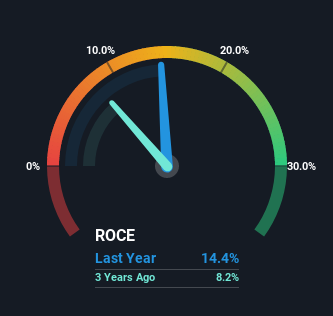InPost's (AMS:INPST) Returns On Capital Are Heading Higher
What are the early trends we should look for to identify a stock that could multiply in value over the long term? Firstly, we'd want to identify a growing return on capital employed (ROCE) and then alongside that, an ever-increasing base of capital employed. This shows us that it's a compounding machine, able to continually reinvest its earnings back into the business and generate higher returns. So when we looked at InPost (AMS:INPST) and its trend of ROCE, we really liked what we saw.
What Is Return On Capital Employed (ROCE)?
Just to clarify if you're unsure, ROCE is a metric for evaluating how much pre-tax income (in percentage terms) a company earns on the capital invested in its business. Analysts use this formula to calculate it for InPost:
Return on Capital Employed = Earnings Before Interest and Tax (EBIT) ÷ (Total Assets - Current Liabilities)
0.14 = zł933m ÷ (zł8.2b - zł1.7b) (Based on the trailing twelve months to September 2022).
So, InPost has an ROCE of 14%. By itself that's a normal return on capital and it's in line with the industry's average returns of 14%.
Check out our latest analysis for InPost
In the above chart we have measured InPost's prior ROCE against its prior performance, but the future is arguably more important. If you'd like to see what analysts are forecasting going forward, you should check out our free report for InPost.
So How Is InPost's ROCE Trending?
InPost has recently broken into profitability so their prior investments seem to be paying off. The company was generating losses five years ago, but now it's earning 14% which is a sight for sore eyes. In addition to that, InPost is employing 1,028% more capital than previously which is expected of a company that's trying to break into profitability. We like this trend, because it tells us the company has profitable reinvestment opportunities available to it, and if it continues going forward that can lead to a multi-bagger performance.
One more thing to note, InPost has decreased current liabilities to 21% of total assets over this period, which effectively reduces the amount of funding from suppliers or short-term creditors. Therefore we can rest assured that the growth in ROCE is a result of the business' fundamental improvements, rather than a cooking class featuring this company's books.
The Bottom Line On InPost's ROCE
To the delight of most shareholders, InPost has now broken into profitability. And since the stock has fallen 20% over the last year, there might be an opportunity here. With that in mind, we believe the promising trends warrant this stock for further investigation.
One more thing to note, we've identified 1 warning sign with InPost and understanding it should be part of your investment process.
While InPost may not currently earn the highest returns, we've compiled a list of companies that currently earn more than 25% return on equity. Check out this free list here.
Have feedback on this article? Concerned about the content? Get in touch with us directly. Alternatively, email editorial-team (at) simplywallst.com.
This article by Simply Wall St is general in nature. We provide commentary based on historical data and analyst forecasts only using an unbiased methodology and our articles are not intended to be financial advice. It does not constitute a recommendation to buy or sell any stock, and does not take account of your objectives, or your financial situation. We aim to bring you long-term focused analysis driven by fundamental data. Note that our analysis may not factor in the latest price-sensitive company announcements or qualitative material. Simply Wall St has no position in any stocks mentioned.
Join A Paid User Research Session
You’ll receive a US$30 Amazon Gift card for 1 hour of your time while helping us build better investing tools for the individual investors like yourself. Sign up here

 Yahoo Movies
Yahoo Movies 
